Online shopping (sometimes known as e-tail from "electronic retail" or e-shopping) is a form of electronic commerce which allows consumers to directly buy goods or services from a seller over the Internet using a web browser. Alternative names are: e-web-store, e-shop, e-store, Internet shop, web-shop, web-store, online store, online storefront and virtual store. Mobile commerce (or m-commerce) describes purchasing from an online retailer's mobile optimized online site or app.
An online shop evokes the physical analogy of buying products or services at a bricks-and-mortar retailer or shopping center; the process is called business-to-consumer (B2C) online shopping. In the case where a business buys from another business, the process is called business-to-business (B2B) online shopping. The largest of these online retailing corporations are Alibaba,Amazon.com, and eBay.
NOW WE DISCUSS about Ethnic Wear
Female clothing[edit]
In India, women's clothing varies widely and is closely associated with the local culture, religion and climate.
Traditional Indian clothing for women in the north and east are saris worn with choli tops; a long skirt called a lehenga or pavada worn with choli and a dupatta scarf to create an ensemble called a gagra choli; or salwar kameez suits, while many south Indian women traditionally wear sari and children wear pattu langa.[citation needed] Saris made out of silk are considered the most elegant. Mumbai, formerly known as Bombay, is one of India's fashion capitals.[citation needed] In many rural parts of India, traditional clothing is worn. Women wear a sari, a long sheet of colourful cloth, draped over a simple or fancy blouse. Little girls wear a pavada. Both are often patterned. Bindi is a part of women's make-up.[citation needed] Indo-western clothing is the fusion of Western and Subcontinental fashion. Other clothing includes the churidar, gamucha, kurti and kurta, andsherwani.
The traditional style of clothing in India varies with male or female distinctions. This is still followed in the rural areas, though is changing in the urban areas. Girls before puberty wear a long skirt (called langa/paawada in Andhra) and a short blouse, called a choli, above it.
Traditional clothing[edit]
Sari and wrapped garments[edit]
Main article: Sari
A saree or sari[22][23] is a female garment in the Indian subcontinent.[24] A sari is a strip of unstitched cloth, ranging from four to nine meters in length, that is draped over the body in various styles. These include: Sambalpuri Sareefrom East, Mysore silk and Ilkal of Karnataka and, Kanchipuram of Tamil Nadu from South, Paithani from West and Banarasi from North among others.[25] The most common style is for the sari to be wrapped around the waist, with one end then draped over the shoulder baring the midriff.[24] The sari is usually worn over a petticoat.[26] Blouse may be "backless" or of a halter neck style. These are usually more dressy with a lot of embellishments such as mirrors or embroidery and may be worn on special occasions. Women in the armed forces, when wearing a sari uniform, don a half-sleeve shirt tucked in at the waist. Teenage girls wear half-sarees, a three piece set consisting of a langa, a choli and a stolewrapped over it like a saree. Women usually wear full sarees. Indian wedding saris are typically red, a tradition that goes back to India's pre-modern history.[27]
Saris are usually known with different names in different places. In Kerala, white saris with golden border, are known as kavanis and are worn on special occasions. A simple white sari, worn as a daily wear, is called a mundu. Saris are called pudavai in Tamil Nadu. In Karnataka, saris are called Seere.[28] The traditional production of handloom sarees is important to economic development in rural communities.[29]
- Mundum Neriyathum
Main article: Mundum Neriyathum
Mundum Neriyathum is the oldest remnant of the ancient form of the saree which covered only the lower part of the body, a traditional dress of women in Kerala, South India.[30][31] The basic traditional piece is the mundu or lower garment which is the ancient form of the saree denoted inMalayalam as 'Thuni' (meaning cloth), while the neriyathu forms the upper garment the mundu.[30][31]
- Mekhela Sador
Main article: Mekhela chador
Mekhela Sador (Assamese: মেখেলা চাদৰ) is the traditional Assamese dress worn by women. It is worn by women of all ages.
There are three main pieces of cloth that are draped around the body.
The bottom portion, draped from the waist downwards is called the Mekhela (Assamese: মেখেলা). It is in the form of a sarong—very wide cylinder of cloth—that is folded into pleats to fit around the waist and tucked in. The folds are to the right, as opposed to the pleats in the Nivi style of the saree, which are folded to the left. Strings are never used to tie the mekhela around the waist, though an underskirt with a string is often used.
The top portion of the three-piece dress, called the Sador (Assamese: চাদৰ), is a long length of cloth that has one end tucked into the upper portion of the Mekhela and the rest draped over and around the rest of the body. The Sador is tucked in triangular folds. A fitted blouse is worn to cover the breasts.
The third piece is called a Riha, which is worn under the Sador. It is narrow in width. This traditional dress of the Assamese women are very famous for their exclusive patterns on the body and the border. Women wear them during important religious and ceremonious occasions of marriage. Riha is worn exactly like a Sador and is used as Orni.
Salwar Kameez[edit]
Main article: Salwar kameez
Salwar is a generic description of the lower garment incorporating the Punjabi salwar, Sindhi suthan, Dogri pajamma (also called suthan) and the Kashmiri suthan.
The salwar kameez is the traditional wear of women in Punjab, Haryana and Himachal Pradesh and is called the Punjabi suit which is most common in the northwestern part of India (Punjab region). The Punjabi suit also includes the "churidaar" and "kurta" ensemble which is also popular in Southern India where it is known as the "churidaar".[32]
The salwar kameez has become the most popular dress for females. It consists of loose trousers (the salwar) narrow at the ankles, topped by a tunic top (the kameez).[33] Women generally wear a dupatta or odani (Veil) with salwar kameez to cover their head and shoulders.[33] It is always worn with a scarf called a dupatta, which is used to cover the head and drawn over the bosom.
The material for the dupatta usually depends upon that of the suit, and is generally of cotton, georgette, silk, chiffon among others.[citation needed] This dress is worn by almost every teenage girl in lieu of western clothes. Many actresses wear the salwar kameez in Bollywood movies.
The suthan, similar to the salwar is common in Sindh where it is worn with the cholo[33] and Kashmir where it is worn with the Phiran.[34] The Kashmiri phiran is similar to the Dogri pajamma. The patiala salwar is an exaggeratedly wide version of the salwar, its loose pleats stitched together at the bottom.[35][36]
- Churidaar
Main article: Churidar
Churidaar is a variation on the salwar, loose above the knees and tightly fitted to the calf below. While the salwar is baggy and caught in at the ankle, the churidar fits below the knees with horizontal gathers near the ankles.[37] The churidaar can be worn with any upper garment such as a long kurta, which goes below the knees, or as part of the anarkali suit.
- Anarkali Suit
Main article: Anarkali Salwar Suit
The anarkali suit is made up of a long, frock-style top and features a slim fitted bottom.The anarkali is an extremely desirable style that is adorned by women located in Northern India, Pakistan and The Middle East. The anarkali suit varies in many different lengths and embroideries including floor length anarkali styles. Many women will also opt for heavier embroidered anarkali suits on wedding functions and events. Indian women wear anarkali suits on various other occasions as well such as traditional festivals,casual lunch, anniversary celebrations etc. The kameez of the anarkali can be sleevelesss or with sleeves ranging from cap- to wrist-length.[38]
Lehenga Choli (skirt and blouse)[edit]
Main article: Ghagra choli
A Ghagra Choli or a Lehenga Choli is the traditional clothing of women in Rajasthan and Gujarat.[citation needed] Punjabis also wear them and they are used in some of their folk dances. It is a combination of lehenga, a tight choli and an odhani. A lehenga is a form of a long skirt which is pleated. It is usually embroidered or has a thick border at the bottom. A choli is a blouse shell garment, which is cut to fit to the body and has short sleeves and a low neck.
Different styles of ghagra cholis are worn by the women, ranging from a simple cotton lehenga choli as a daily wear, a traditional ghagra with mirrors embellished usually worn during navratri for the garba dance or a fully embroidered lehenga worn during marriage ceremonies by the bride.
- Pattu Pavadai/Reshme Langa
Main article: Pattu pavadai
Pattu Pavadai or Langa davani is a traditional dress in south India and Rajasthan, usually worn by teenage and small girls. The pavada is a cone-shaped skirt, usually of silk, that hangs down from the waist to the toes. It normally has a golden border at the bottom.
Girls in south India often wear pattu pavadai or Langa davani during traditional functions. Girls in Rajasthan wears this dress before marriage (and after marriage with sight modification in certain section of society. )
- Langa - Voni/Dhavani
This is a type of South Indian dress mainly worn in Karnataka,Andhra Pradesh and Tamil Nadu also in some parts of Kerala . This dress is a 3-piece garment where the langa or lehanga is the cone shaped long flowing skirt.
Male clothing[edit]
Traditional clothing[edit]
For men, traditional clothes are the Sherwani, Lungi, Kurta, Angarkha, Jama and Dhoti or Pajama. Additionally, recently pants and shirts have been accepted as traditional Indian dress by the Government of India.[40]
Dhoti[edit]
Main article: Dhoti
A dhoti is from four to six feet long white or colour strip of cotton. This traditional attire is mainly worn by men in villages.[41] It is held in place by a style of wrapping and sometimes with the help of a belt, ornamental and embroidered or a flat and simple one, around the waist.[42]
In India men also wear long, white sarong like sheets of cloth known as Mundu. It's called dhotar in Marathi. In north and central Indian languages like Hindi, and Odia, these are called Mundu, while in Telugu they are called Pancha, in Tamil they are called veshti and in Kannada it is calledPanche/Lungi. Over the dhoti, men wear shirts.
Panche or Lungi[edit]
A Lungi, also known as sarong, is a traditional garment of India. A Mundu is a lungi, except that it is always white.[42] It is either tucked in, over the waist, up to knee-length or is allowed to lie over and reach up to the ankle. It is usually tucked in when the person is working, in fields or workshops, and left open usually as a mark of respect, in worship places or when the person is around dignitaries.
Lungis, generally, are of two types: the open lungi and the stitched lungi. The open lungi is a plain sheet of cotton or silk, whereas the stitched one has both of its open ends stitched together to form a tube like structure.
Though mostly worn by men, elderly women also prefer lungi to other garments owing to its good aeration.[43] It is mostly popular in south India, though people of Bangladesh, Brunei, Indonesia, Malaysia, Myanmar and Somalia also can be seen in lungis, because of the heat and humidity, which create an unpleasant climate for trousers, though trousers have now become common outside the house.[44]
Sherwani[edit]
Main article: Sherwani
A Sherwani is a long coat / jacket that usually sports exposed buttons through the length of the jacket. The length is usually just below the knees and the jacket ends just below the knee. The jacket has a Nehru collar,[45] which is a collar that stands up.[citation needed] The Sherwani is worn with tight fitting pants or trousers called churidars. Churidars are trousers that are loose around the hips and thighs, but are tight and gathered around the ankle.[40] Sherwani is usually worn during the wedding ceremonies by the groom and is usually cream, light ivory, or gold coloured.[citation needed]It may be embroidered with gold or silver. A scarf called a dupatta is sometimes added to the sherwani.
Jama[edit]
The jama is a long coat which was popular during the Mughal period. There are many types of jama costumes which were worn in various regions of South Asia, the use of which began to wane by the end of the 19th century A.D.[46] However, men in parts of Kutch still wear the jama also known as the angarkha[47]which has an asymmetric opening with the skirt flaring out to around the hips.[48] However, some styles fall to below the knees.
Headgear[edit]
The Indian turban or the pagri is worn in many regions in the country, incorporating various styles and designs depending on the place. Other types of headgear such as the Taqiyah and Gandhi cap are worn by different communities within the country to signify a common ideology or interest.
Dastar[edit]
Main article: Dastar
The Dastar, also known as a pagri, is a turban worn by the Sikh community of India. Is a symbol of faith representing values such as valour, honour and spirituality among others. It is worn to protect the Sikh's long, uncut hair, the Kesh which is one of the Five Ks ofSikhism.[49] Over the years, the dastar has evolved into different styles pertaining to the various sects of Sikhism such as the Nihang and the Namdhari.[50]
Pheta[edit]
Main article: Pheta (turban)
Pheta is the Marathi name for turbans worn in the state of Maharashtra. Its usually worn during traditional ceremonies and occasions. It was a mandatory part of clothing in the past and have evolved into various styles in different regions.[51] The main types are the Puneri Pagadi, Kolhapuri and Mawali pheta.[52]
Mysore Peta[edit]
Main article: Mysore Peta
Originally worn by the kings of Mysore during formal meeting in durbar and in ceremonial processions during festivals, and meeting with foreign dignitaries, the Mysore peta has come to signify the cultural tradition of the Mysore and Kodagu district.[53] The Mysore University replaced the conventional mortarboard used in graduation ceremonies with the traditional peta.[54]
Rajasthani safa[edit]
Turbans in Rajasthan are called pagari or "safa". They are distinctive in style and colour, and indicate the caste, social class and region of the wearer. In the hot and dry regions, turbans are large and loose. The paggar is traditional in Mewar while the safa is to Marwar.[55] The colour of the pagaris have special importance and so does the pagari itself. In the past, saffron stood for valour and chivalry. A white turban stood for mourning. The exchange of a turban meant undying friendship.[56][57]
Gandhi cap[edit]
Main article: Gandhi cap
The Gandhi cap, a white coloured cap made of khadi was popularised by Mahatma Gandhi during the Indian independence movement. The practice of wearing a Gandhi cap was carried on even after independence and became a symbolic tradition for politicians and social activists. The cap has been worn throughout history in many states such as Gujarat, Maharashtra, Uttar Pradesh and West Bengal and is still worn by many people without political significance. In 2013, the cap regained its political symbolism through the Aam Aadmi Party, which flaunted Gandhi caps with "I am a Common Man" written over it. This was partly influenced by the "I Am Anna" caps used during Anna Hazare's Lokpal movement. During the Delhi Legislative Assembly election, 2013, these caps led to a scuffle between Aam Aadmi Party and Congress workers, based on the reasoning that Gandhi caps were being used for political benefits.[58]
Contemporary clothing[edit]
Main article: Fashion in India
Main article: Indo-Western clothing
During the 1960s and 1970s, at the same time as Western fashion was absorbing elements of Indian dress, Indian fashion also began to actively absorb elements of Western dress.[59][60] Throughout the 1980s and 1990s, Western designers enthusiastically incorporated traditional Indian crafts, textiles and techniques in their work at the same time as Indian designers allowed the West to influence their work.[59][60] By the turn of the 21st century, both Western and Indian clothing had intermingled creating a unique style of clothing for the typical urban Indian population. Women started wearing more comfortable clothing and exposure to international fashion led to a fusion of western and Indian styles of clothing.[59][60]Following the economic liberalisation, more jobs opened up, and created a demand for formal wear. While women have the choice to wear either Western or traditional dress to work,[61] most Indian multinational companies insist that male employees wear Western dress.
Women's clothing in India nowadays consist of both formal and casual wear such as gowns, pants, shirts and tops. Traditional Indian clothing such as the kurti have been combined with jeans to form part of casual attire.[60] Fashion designers in India have blended several elements of Indian traditional designs into conventional western wear to create a unique style of contemporary Indian fashion.[59][60]

















